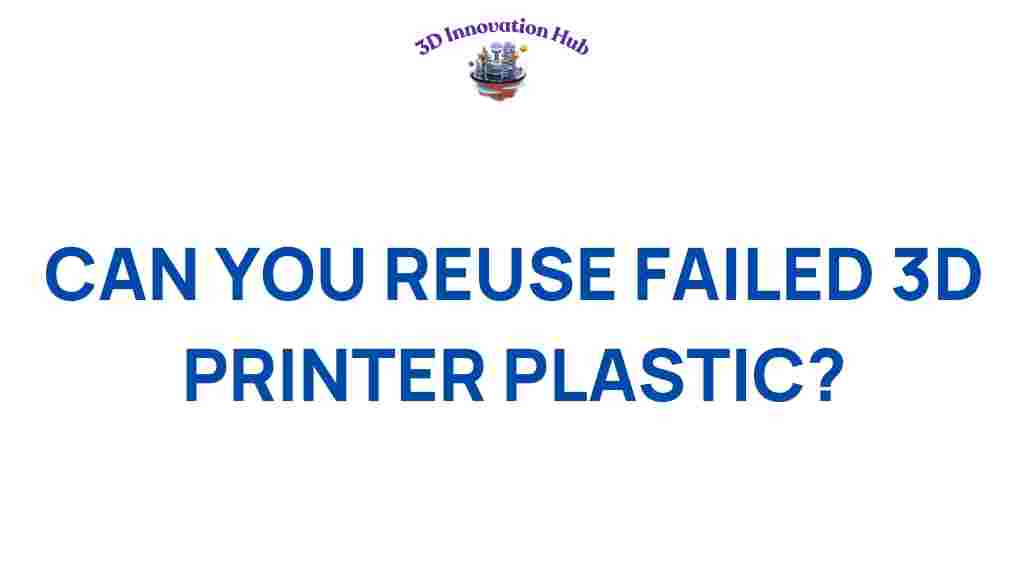Can Failed 3D Printer Plastic Be Reused? Exploring the World of 3D Printing and Recycling
In the realm of 3D printing, the innovation and creativity brought forth by this technology are often met with challenges. One of the significant challenges faced by hobbyists and professionals alike is dealing with failed prints. Whether it’s due to technical issues, material defects, or design flaws, these failures often result in a substantial amount of plastic waste. This raises the question: can failed 3D printer plastic be reused? In this article, we will delve into the possibilities of recycling failed prints, focusing on sustainability, waste reduction, and the future of eco-friendly manufacturing.
Understanding 3D Printing and Its Challenges
3D printing is a revolutionary process that enables the creation of three-dimensional objects from digital files. While it has transformed industries and sparked innovation, it also poses environmental challenges, particularly concerning waste. Each failed print contributes to the growing problem of plastic waste, making it vital to explore ways to mitigate this issue.
The Importance of Sustainability in 3D Printing
As the world increasingly prioritizes sustainability, the 3D printing industry is also recognizing its responsibility. By focusing on waste reduction and the recycling of materials, manufacturers and hobbyists can contribute to a more sustainable future. The ability to reuse failed prints not only conserves resources but also reduces the environmental impact of plastic waste.
Can Failed 3D Printer Plastic Be Reused? A Step-by-Step Process
Yes, failed 3D printer plastic can be reused, and the process is relatively straightforward. Here’s how you can turn your failed prints into valuable materials for future projects:
Step 1: Collect and Sort Failed Prints
- Gather all your failed prints and sort them by material type (e.g., PLA, ABS, PETG).
- Remove any non-recyclable components, such as supports or rafts, that are not made from the same material.
Step 2: Shred the Plastic
To reuse failed prints, you’ll need to shred the plastic into smaller pieces. This can be done using:
- A dedicated plastic shredder
- A multi-tool or heavy-duty scissors for smaller volumes
- Manual shredding, although this can be time-consuming
Shredding increases the surface area and makes it easier to melt and reprocess the plastic.
Step 3: Melt and Extrude the Filament
Once the plastic is shredded, the next step is to melt it down and extrude it into filament:
- Use a filament extruder designed for the type of plastic you are working with.
- Set the extruder to the appropriate temperature for the material (e.g., around 180-220°C for PLA).
- Feed the shredded plastic into the extruder and collect the newly formed filament.
Step 4: Test the New Filament
Once you have extruded your filament, it’s essential to test it:
- Print a small test object to assess the quality of the filament.
- Check for consistency in diameter and strength.
If the filament performs well, you can integrate it into your 3D printing projects.
Step 5: Store and Label Your Filament
Proper storage is crucial for maintaining the quality of your recycled filament:
- Store filament in a cool, dry place to prevent moisture absorption.
- Label your filament with material type and any specific characteristics (e.g., recycled).
Environmental Benefits of Recycling Failed Prints
Recycling failed prints has numerous environmental benefits, including:
- **Waste Reduction**: By reusing materials, you significantly decrease the amount of plastic waste produced.
- **Resource Conservation**: Recycling reduces the need for new raw materials, conserving resources and energy.
- **Lower Carbon Footprint**: The process of recycling can result in a lower carbon footprint compared to producing new filament from virgin materials.
Troubleshooting Tips for Recycling Failed Prints
While recycling failed prints is a sustainable practice, you may encounter some challenges. Here are some troubleshooting tips to help you along the way:
Common Issues and Solutions
- Issue: Filament jams during extrusion.
Solution: Ensure the shred size is consistent and the extruder is set to the correct temperature. - Issue: Weak or brittle filament.
Solution: Mix different types of plastics to improve strength and flexibility. - Issue: Filament moisture absorption.
Solution: Dry the shredded plastic before extruding.
Maintaining Quality Control
To ensure the best results when recycling failed prints, maintain strict quality control:
- Regularly monitor the extrusion process.
- Conduct tests on the filament before large print jobs.
- Keep records of each batch of recycled filament for future reference.
The Future of 3D Printing and Recycling
As the 3D printing industry continues to evolve, the focus on sustainability and recycling will become increasingly important. Innovations in materials science and recycling technology will likely lead to:
- The development of more eco-friendly filaments.
- Improved processes for recycling and reusing failed prints.
- A growing community of makers dedicated to sustainable practices.
With companies investing in research and development, the potential for recycled filament in manufacturing is vast. This trend not only benefits the environment but also appeals to consumers who prioritize eco-friendly options.
Conclusion: Embracing Eco-Friendly Practices in 3D Printing
In conclusion, the journey of failed 3D printer plastic does not have to end in waste. By embracing recycling, makers can contribute to a more sustainable future while fostering innovation in the 3D printing community. The ability to reuse failed prints is not only a practical solution but also a step towards reducing our carbon footprint and promoting waste reduction.
As technology advances, we can expect even more efficient ways to recycle and reuse materials in the 3D printing process. By prioritizing sustainability, we pave the way for a greener future and inspire others in the manufacturing sector to follow suit. For more insights on eco-friendly practices, check out this resource on sustainable 3D printing.
Join the movement towards a sustainable future by exploring the possibilities of recycling failed prints in your own projects. With creativity and innovation, we can turn waste into a resource and build a better tomorrow.
This article is in the category and created by 3D Innovation Hub Team
